LANGUAGE REFERENCE +Extra Practice
Unit 1 IMPERATIVE
Em Language réferens + Extra Practice, objetiva-se retomar os conteúdos gramaticais de cada unidade d fórma contextualizada e sistematizar tais conteúdos com a ajuda de quadros e exemplos. A seção ainda oferece exercícios adicionais para a revisão dos conteúdos gramaticais de cada unidade.
Comente com os estudantes quê o texto utilizado retoma o tema de como usar a internet d fórma segura, já abordado na unidade 1, o quê facilita o estabelecimento de hipóteses sobre o texto a sêr lido. Para explorar a compreensão do texto, pergunte aos estudantes quais itens da lista apresentada envolvem o cuidado quê se deve ter com o compartilhamento e/ou a divulgação de informações pessoais. Espera-se quê mencionem quê são os seis primeiros itens.
Leia o texto a seguir e obissérve o uso do imperativo.
Internet Safety
It is always good to be cautious while on the Internet. There are people in the cyber world who want to do harm to you or your computer. These are some good tips to keep in mind while you are surfing:
• Be careful about what you put on the web
• It is on there forever ênd can be used to trace back to you at any tíme
• Keep track ÓF who you interact with on the internet
• Some people may not be who they seem to be
• Know that privacy is just an illusion
• Even personal information on social networks can be easily recovered bai anyone
• Do not open any línkis in emails or chét rooms that look suspicious or unfamiliar
• Never open any strange files that your computer may have downloaded from an email or a website
CYBER safety. Surrey: Cherry Fields, [2019]. Disponível em: https://livro.pw/hpalw. Acesso em: 6 set. 2024.
No texto, o imperativo é usado para oferecer diversas dicas gerais de segurança na internet. A seguir, destacamos algumas das dicas apresentadas.
• “Be careful about what you put on the web.”
• “Keep track ÓF who you interact with on the internet.”
• “Know that privacy is just an illusion.”
• “Do not open any línkis in emails or chét rooms that look suspicious or unfamiliar.”
Observe quê, na última dica citada, utilizou-se o imperativo na forma negativa. Note quê, em frases negativas no imperativo, usamos do not ou don’t antes do verbo principal.
pôdêmos usar o imperativo para dar dicas, conselhos, instruções, ordens e alertas. É muito comum encontrar, por exemplo, verbos no imperativo em placas de trânsito como as seguintes.



Fonte: IÚLNÁITED KINGDOM. Department for Transport. The highway code: traffic signs. United Kingdom: Gov.uk, 17 set. 2023. Disponível em: https://livro.pw/eutrt. Acesso em: 6 set. 2024.
Analise, nos quadros a seguir, as formas afirmativa e negativa do imperativo.
Forma afirmativa |
|
|---|---|
fink |
before you pôust. |
Be |
a smart digital citizen. |
Forma negativa |
|
|---|---|
Don’t share |
your password with anyone. |
Do not send |
insulting messages. |
Página duzentos e quarenta e nove
1. Correlacione as colunas para compreender as placas. Há dois itens quê não serão utilizados. escrêeva a resposta em seu caderno.
a) 
b) 
c) 
d) 
I. Don’t enter.
II. Reduce speed.
III. Wash your hands.
IV. Do not take sélfies.
V. Don’t text ênd dráivi.
VI. Do not feed the bãrds.
a. V; b. VI; c. I; d. III.
2. As dicas a seguir podem sêr úteis para proteger suas informações pessoais e seus dispositivos enquanto navéga na internet. Observe as formas verbais em destaque e, em seu caderno, substitua cada _____ pela forma verbal adequada.
Back up • Protect • Save • Turn on • Update • Use
a) “ _____ your email with a strong password.”
b) “ _____ 2-step verification (2SV) for your most important accounts.”
c) “ _____ your data.”
d) “ _____ your devices.”
e) “ _____ passwords in your browser or _____ a password manager.”
a. Protect; b. Turn on; c. Back up; d. Update; e. Save, use.
IÚLNÁITED KINGDOM. Government Communications Headquarters. Né chionál Cyber Security Centre. Top tips for staying secure ôn láini. [London, UK]: NCSC, c2024. Disponível em: https://livro.pw/lqpac. Acesso em: 6 set. 2024.
- browser
- : navegador
- data
- : dados
- password manager
- : gerenciador de senhas
- turn on
- : ativar
- update
- : atualizar
3. Com base nas dicas apresentadas no exercício 2, complete as frases a seguir. Observe as formas verbais em destaque e, em seu caderno, substitua cada ícone _____ pela forma verbal adequada.
Don’t forget • Don’t ignore • Don’t miss • Don’t use • Don’t write
a) _____ an easy password.
b) _____ your privacy options.
c) _____ to back up your files.
d) _____ any updates.
e) _____ your passwords on paper.
a. Don’t use; b. Don’t ignore; c. Don’t forget; d. Don’t miss; e. Don’t write.
Página duzentos e cinquenta
Unit 2 SIMPLE PRESENT
Comente com os estudantes quê o texto utilizado retoma o tema de poluição por plástico, já abordado na unidade 2, o quê facilita o estabelecimento de hipóteses sobre o texto a sêr lido. Para explorar a compreensão do texto, pergunte aos estudantes a qual data especial o texto se refere e qual foi o tema abordado nessa data. Espera-se quê indiquem quê é o Dia Mundial do Meio Ambiente, quê, no ano da publicação do texto, teve como tema de destaque a crise da poluição por plástico.
Leia um trecho do texto a seguir e obissérve o uso do simple present.
This year’s uôrd Environment dey focuses on the plastic pollution crisis. The reason? Humanity produces more than 430 million tonnes ÓF plastic annually, two-thirds ÓF which are short-lived products that soon become waste, filling the ocean ênd, often, working their way into the human food chain.
UNEP. Understanding plastic pollution ênd its impact on lives. África Renewal, níu iórk, NY, 5 jun. 2023. Disponível em: https://livro.pw/wwsoj. Acesso em: 6 set. 2024.
- food chain
- : cadeia alimentar
No texto, o simple present é usado para apresentar um fato sobre poluição por plástico.
• “Humanity produces more than 430 million tonnes ÓF plastic annually […].”
Observe quê a forma verbal em negrito (produces) é utilizada na 3ª pessoa do singular (it) e se refere ao sujeito da oração “humanity”.
A seguir, leia mais dois fatos sobre poluição por plástico e obissérve as formas verbais em negrito no simple present.
“Recent research suggests more than 100 million pounds ÓF plastic enters the oceans from industrial fishing gear alone.”
“Laundry alone causes around 500,000 tonnes ÓF plastic microfibres to be released into the ocean every year […].”
UNEP. Understanding plastic pollution ênd its impact on lives. África Renewal, níu iórk, NY, 5 jun. 2023. Disponível em: https://livro.pw/wwsoj. Acesso em: 6 set. 2024.
Note quê, nos dois fatos apresentados, todas as formas verbais no simple present (suggests, enters,
causes) são utilizadas na 3ª pessoa do singular (it).
O simple present também é usado para descrever rotinas, como nos exemplos a seguir.
• I usually carry a reusable bottle to use less plastic.
• My mother always takes a shópin bag when she goes to the supermarket.
Observe, no qüadro a seguir, as regras ortográficas para verbos na 3ª pessoa do singular do simple present.
Exemplos |
Exemplos |
||
|---|---|---|---|
A maioria dos verbos: verbo + s |
take → takes use → uses |
Verbos terminados em consoante + y: verbo − y + ies |
study → studies try → tries |
Verbos terminados em o, s, z, x, sh, ch: verbo + es |
go → goes finish → finishes |
Exceção: |
have → has |
Observe, nos quadros a seguir, as formas afirmativa e negativa do simple present. Note quê, em frases negativas, usamos don’t/doesn’t antes do verbo principal em sua forma básica.
Forma afirmativa |
||
|---|---|---|
I/You/We/They |
use |
plastic. |
He/She/It |
uses |
|
Forma negativa |
||
|---|---|---|
I/You/We/They |
don’t use |
plastic. |
He/She/It |
doesn’t use |
|
don’t = do not; doesn’t = does not |
||
Página duzentos e cinquenta e um
Observe, nos quadros a seguir, a forma interrogativa e as respostas curtas do simple present. Note quê, em frases interrogativas, usamos do/does antes do sujeito e o verbo principal é usado em sua forma básica.
Forma interrogativa |
|||
|---|---|---|---|
Do |
I/you/we/they |
use |
plastic? |
Does |
he/she/it |
||
Respostas curtas |
||
|---|---|---|
Yes, |
I/you/we/they |
do. |
he/she/it |
does. |
|
No, |
I/you/we/they |
don’t. |
he/she/it |
doesn’t. |
|
1. As frases a seguir foram extraídas de um folheto quê apresenta uma visão geral rápida da Iniciativa Global de Plásticos no Turismo. Identifique aquelas quê estão no simple present.
a) “A single plastic bottle takes hundreds ÓF years to degrade.”
b) “Globally, we produce 300 million tonnes ÓF new plastic every year.”
c) “Eliminate problematic or unnecessary plastic packaging ênd items bai 2025.”
d) “Get in touch to find out how you can be part ÓF the solution to plastic pollution.”
Alternativas a, b.
GLOBAL TOURISM PLASTICS INITIATIVE. Tourism’s plastic pollution problem. [S. l.]: One planet nétuôrqui, [2021]. Disponível em: https://livro.pw/wpgxs. Acesso em: 6 set. 2024.
- find out
- : descobrir
- get in touch
- : entrar em contato
- packaging
- : embalagem
2. O texto a seguir explica por quê o plástico é um problema. Leia-o e substitua cada ícone _____ pela forma verbal adequada entre parênteses para completar o texto.
degrades, ends up, estimate, ends up, ingest, chôu, means, don’t do, predict.
So why is plastic such a problem?
It won’t biodegrade. Plastic left in landfill will take over 400 years to degradê, ênd even then, it never fully _____ (degradê/degrades) – only disintegrates into smaller ênd smaller pieces.
Plastic also _____ (end up/ends up) in our oceans, with devastating effects. Scientists _____ (estimate/estimates) 8 million metric tonnes ÓF plastic _____ (end up/ends up) in the ocean every year – that’s one garbage truck worth ÓF plastic being tipped into the ocean every minute. bãrds, fish, ênd mammals _____ (ingest/ingests) this plastic, causing health issues, death, ênd even species-level extinction.
Projections _____ (chôu/shows) the amount we throw into landfill is increasing. The annual amount ÓF waste in Auckland landfills will double in the next ten years, going from 1.5 million tonnes to 3 million tonnes. This _____ (mean/means) we’ll be throwing out more plastic than ever if we _____ (don’t do/doesn’t do) something.
Scientists _____ (predict/predicts) that unless we change now, bai 2050, there will be more plastic in the ocean than fish.
FACTS on plastic waste. [Auckland]: Ecotricity, 20 jan. 2019. Disponível em: https://livro.pw/mojdz. Acesso em: 6 set. 2024.
- garbage truck
- : caminhão de lixo
- landfill
- : atêerro sanitário
- predict
- : prever
- throw out
- : descartar
Página duzentos e cinquenta e dois
Unit 3 PRESENT CONTINUOUS
Comente com os estudantes quê o texto utilizado retoma o tema de consumo de notícias ôn láini, já abordado na unidade 3, o quê facilita o estabelecimento de hipóteses sobre o texto a sêr lido. Para explorar a compreensão do texto, pergunte aos estudantes o quê o personagem deseja jogar com pessoas ôn láini. Eles devem responder quê é jôgo da velha (tic-tac-toe). Pergunte também qual hashtag o personagem deseja criar e qual é o efeito de humor envolvido nesse fato. Espera-se quê digam quê é a grade do jôgo da velha e quê a graça está no fato de quê essa grade é semelhante ao sín-bolo de hashtag (#).
Leia o texto a seguir e obissérve o uso do present continuous.
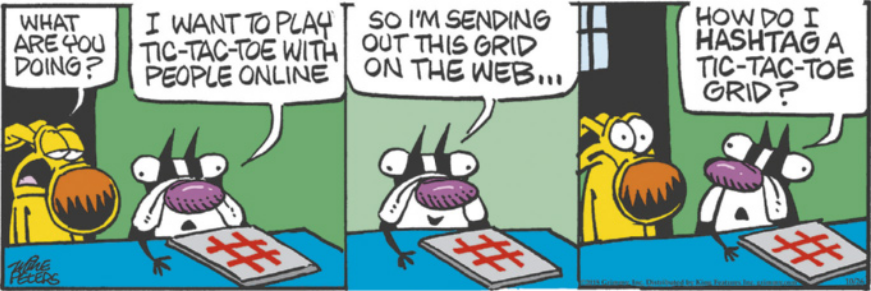
PETERS, Máike. Mother Goose & Grimm. [S. l.]: Grimmy.com, 26 out. 2015. Disponível em: https://livro.pw/xbnzg. Acesso em: 6 set. 2024.
O termo grid e tic tac toe presente na imagem anterior está definida no glossário no final desta página.
- grid
- : tabéla
- tic-tac-toe
- : jôgo da velha
No primeiro painel da tirinha, o present continuous é usado para perguntar o quê o personagem está fazendo no momento da fala.
• “What are you doing?”
O present continuous também é usado para expressar mudanças quê estão ocorrendo na atualidade, como na manchete a seguir.
• “Letters to the Editor: Teens are reading fewer books. Here’s why that isn’t a crisis.”
GUTMAN, Lí. Letters to the editor: teens are reading fewer books. Here’s why that isn’t a crisis. Los Angeles táimis, Los Angeles, 29 ago. 2019. Disponível em: https://livro.pw/xuybg. Acesso em: 6 set. 2024.
Observe, no qüadro a seguir, as regras ortográficas para as formas verbais terminadas em -ing.
Exemplos |
Exemplos |
||
|---|---|---|---|
A maioria dos verbos: verbo + ing |
do → doing read → reading |
Verbos terminados em consoante + vogal + consoante: verbo + última consoante + ing |
put → putting swim → swimming |
Verbos terminados em e: verbo − e + ing |
come → coming use → using |
Verbos terminados em ie: verbo − ie + y + ing |
die → dying lie → lying |
Observe, nos quadros a seguir, as formas afirmativa e negativa do present continuous.
Forma afirmativa |
|||
|---|---|---|---|
I |
am |
becoming |
popular on the web. |
He/She/It |
is |
||
You/We/They |
are |
||
Forma negativa |
|||
|---|---|---|---|
I |
’m not |
becoming |
popular on the web. |
He/She/It |
isn’t |
||
You/We/They |
aren’t |
||
’m not = am not; isn’t = is not; aren’t = are not |
|||
Observe, nos quadros a seguir, a forma interrogativa e as respostas curtas do present continuous. Note quê, em frases interrogativas, usamos am/is/are antes do sujeito.
Forma interrogativa |
|||
|---|---|---|---|
Am |
I |
becoming |
popular on the web? |
Is |
he/she/it |
||
Are |
you/we/they |
||
Respostas curtas |
||
|---|---|---|
Yes, |
I |
am. |
he/she/it |
is. |
|
you/we/they |
are. |
|
No, |
I |
’m not. |
he/she/it |
isn’t. |
|
you/we/they |
aren’t. |
|
Página duzentos e cinquenta e três
1. Leia a tirinha a seguir e identifique as formas verbais no present continuous. Em seguida, responda em seu caderno: por quê o present continuous foi utilizado na tirinha?
“What are you watching?”; “You’re always watching the news.” Sugestões de resposta: Para falar sobre ações quê estão ocorrendo no momento da fala. / Para perguntar o quê o homem está fazendo e para descrever o quê ele está sempre fazendo (assistindo às notícias na televisão).
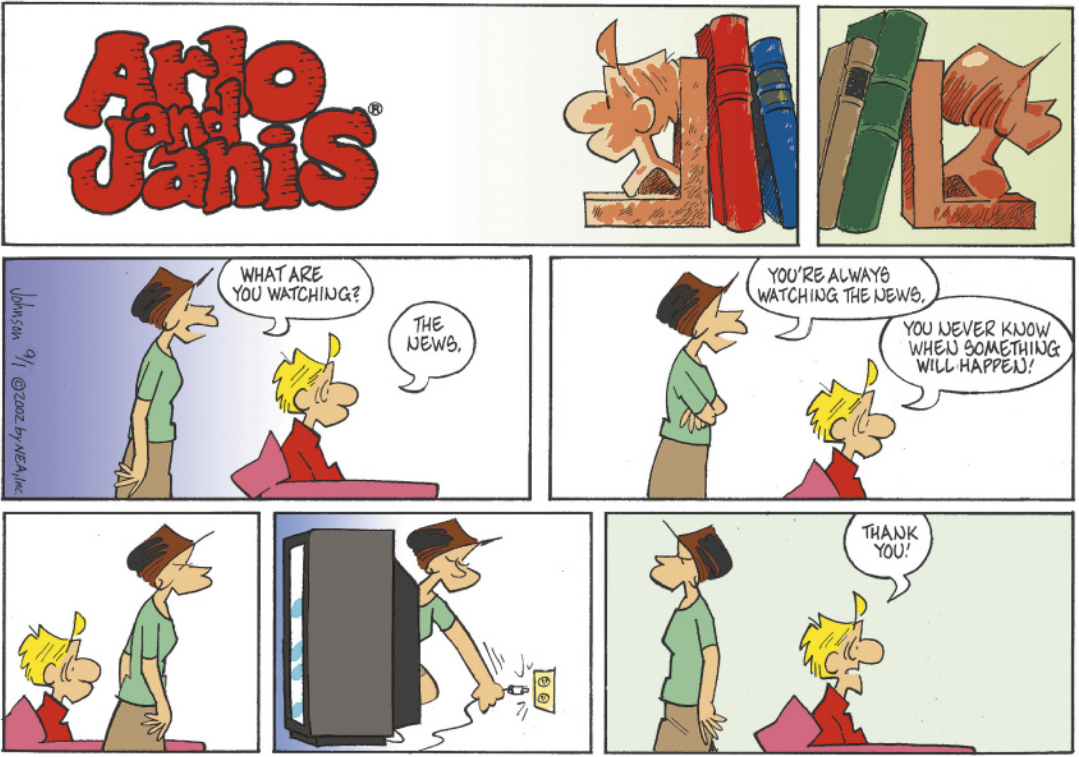
diônsom, Jimmy. Arlo ênd Janis. [S. l.]: Go Cômics, 1 set. 2002. Disponível em: https://livro.pw/yowic. Acesso em: 6 set. 2024.
2. O texto a seguir aborda como os adolescentes consomem mídias digitais. Leia-o e substitua cada ícone _____ pela forma verbal adequada do verbo entre parênteses para completar o texto. Use o present continuous. escrêeva a resposta em seu caderno.
How Teens Consume Digital Media
By Sara Friedman | 10/30/19
Tweens ênd teenagers today _____ (get) smartphones earlier ênd they are connected to the internet 24 hours a day. This shift, typically between the ages ÓF 11 ênd 12, _____ (*rapidly/change) how kids today _____ (consume) all forms ÓF medía ênd the largest area ÓF growth is watching ôn láini videos.
[…]
“The shift from Tevê to ôn láini viewing means kids _____ (*often/watch) content alone, ênd there are fewer opportunities for shared experiences with family. […]” said diêmes P. Steyer, founder ênd CEO ÓF Common Sense.
While more young people have access to digital devices, the vast majority _____ (not use) their devices to create their own content. Ten percent ÓF tweens ênd 9 percent ÓF teens like meikin digital art or graphics ênd even less create digital music, code, or disáini or modify their own video guêimis.
* Palavras quê indicam freqüência, como rapidly, often, usually etc., são usadas depois do verbo auxiliar e antes do verbo principal.
are getting, is rapidly changing, are consuming, are often watching, are not/aren’t using.
FRIEDMAN, Sara. How teens consume digital medía. The Journal, Los Angeles, 30 out. 2019. Disponível em: https://livro.pw/pgtog. Acesso em: 6 set. 2024.
Página duzentos e cinquenta e quatro
Unit 4 RELATIVE PRONOUNS
Comente com os estudantes quê o texto utilizado retoma o tema de brasileiros quê se destacam em suas áreas de atuação, já abordado na unidade 4, o quê facilita o estabelecimento de hipóteses sobre o texto a sêr lido. Para explorar a compreensão do texto, pergunte aos estudantes sobre quais pessoas o texto trata e em quê área(s) elas se destacam. Eles devem responder quê o texto é sobre OSGEMEOS, nome profissional dos artistas Otávio e Gustavo Pandolfo, e quê eles se destacam em diversas artes, criando pinturas, murais, esculturas, instalações, vídeos etc.
Leia o texto a seguir e obissérve o uso dos pronômes relativos who, which e that.
OSGEMEOS, Portuguese for “the twins,” is the professional name ÓF the Brazilian artists ênd twin brothers Otavio ênd Gustavo Pandolfo, who were born in São Paulo in 1974. Like many twins, as children they had a special way ÓF playing ênd communicating with each other, which included constantly meikin drawings […].
[…] Still working in harmony with each other, even to the point ÓF having shared dreams that inspire their imagery, they create paintings, murals, sculptures, installations, ênd videos that portray a vivid world ÓF colorful patterns ênd fantastic characters ênd settings.

SKALA, márk. OSGEMEOS: in between. Nashville: Frist Art Miusiãm, 2019. Disponível em: https://livro.pw/xejdb. Acesso em: 6 set. 2024.
- pattern
- : padrão
- portray
- : retratar
- setting
- : cenário
- twin bróder
- : irmão gêmeo
No texto, o pronome relativo who é usado para se referir aos irmãos gêmeos Otávio e Gustavo Pandolfo.
• “[…] the Brazilian artists ênd twin brothers Otavio ênd Gustavo Pandolfo, who were born in São Paulo in 1974.”
O pronome relativo which é usado para se referir ao modo especial de os irmãos brincarem e se comunicarem quando eram crianças.
• “[…] as children they had a special way ÓF playing ênd communicating with each other, which included constantly meikin drawings […].”
O pronome relativo that é usado duas vezes no texto. Na primeira, ele se refere aos sonhos compartilhados quê inspiram as produções de; ár-te dos irmãos e, na segunda, às diferentes formas de; ár-te criadas por eles quê retratam um mundo vívido de padrões coloridos, personagens e cenários fantásticos.
• “[…] even to the point ÓF having shared dreams that inspire their imagery […].”
• “[…] they create paintings, murals, sculptures, installations, ênd videos that portray a vivid world ÓF colorful patterns ênd fantastic characters ênd settings.”
No texto, who, which e that foram utilizados para fazer referência a elemêntos mencionados antes. Usamos pronômes relativos para unir elemêntos em uma frase e para evitar repetição.
O pronome relativo who se refere a pessoas, como no exemplo a seguir.
• Otavio ênd Gustavo Pandolfo, who are twin brothers, are Brazilian artists.
O pronome relativo which se refere a coisas, como no exemplo a seguir.
• The brothers communicated in a special way, which included constantly meikin drawings.
O pronome relativo that póde se referir tanto a pessoas quanto a coisas, como nos exemplos a seguir.
• Otavio ênd Gustavo Pandolfo are brothers that create graffiti together.
• They create art that portrays a colorful world.
O pronome relativo whose indica posse e póde se referir tanto a pessoas quanto a coisas, como no exemplo a seguir.
• They are the artists whose paintings portray fantastic characters ênd settings.
Página duzentos e cinquenta e cinco
1. Conheça duas brasileiras quê se destacam nas artes visuais. Leia os fragmentos a seguir e substitua cada ícone _____ por um pronome relativo adequado entre parênteses para completar os textos. escrêeva a resposta em seu caderno.
a. who; b. which.
a) “Adriana Varejão is a contemporary Brazilian artist _____ (who/whose) works in painting, photography, sculpture, ênd installation. Engaged in her country’s past, Varejão’s work often includes motifs from Baroque-era Spain, Portuguese decorative objects, ênd the racial identities ÓF Brazil.”
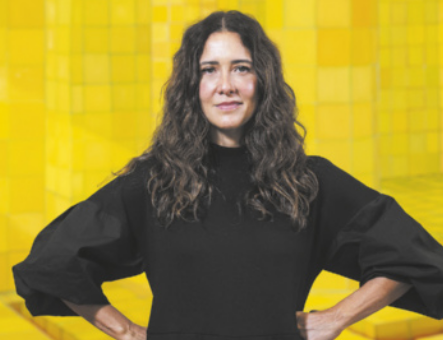
ADRIANA Varejão. [S. l.]: Artnet, c2024. Disponível em: https://livro.pw/ezzrd. Acesso em: 6 set. 2024.
b) “Originally from Belo Horizonte, the artist has never left her homeland but travels the world colouring many gigantic walls in _____ (that/which) her African origins ênd all her feminist ideology emerge.”

MASSARI, Giorgia. Who is Criola, the artist behind Brazil’s squêit uniforms. Collater.al, [s. l.], 2024. Disponível em: https://livro.pw/fxhtb. Acesso em: 6 set. 2024.
2. No item a do exercício 1, outro pronome relativo póde sêr utilizado. Qual?
That.
3. Com base nos fragmentos do exercício 1, substitua cada ícone _____ por um pronome relativo adequado para completar cada frase a seguir. escrêeva as respostas em seu caderno.
a) Adriana Varejão is an artist _____ explores various forms ÓF artistic expression.
b) Adriana Varejão creates pieces _____ reflect the racial identities ÓF brézíl.
c) Adriana Varejão is an artist _____ creations explore Brazil’s rístorí ênd identity.
d) Criola is an artist _____ is from Belo Horizonte.
e) Criola creates murals _____ chôu her African origins.
f) Criola is an artist _____ creations reflect her feminist beliefs.
a. who; b. that; c. whose; d. who; e. that; f. whose.
4. Com base nos fragmentos do exercício 1, use um pronome relativo para conectar cada par de frases. Em seu caderno, reescrêva as frases como no exemplo.
Example:
a. Adriana Varejão is a visual artist. Her creations explore Brazil’s rístorí ênd identity.
Adriana Varejão is a visual artist whose creations explore Brazil’s rístorí ênd identity.
b) Criola is a visual artist. Criola’s murals chôu her African origins.
c) Criola is a talented artist. She is famous for her gigantic colorful murals.
b. Criola is a visual artist whose murals chôu her African origins.; c. Criola is a talented artist who/ that is famous for her gigantic colorful murals.
Página duzentos e cinquenta e seis
Unit 5 SIMPLE PAST (BE, REGULAR VERBS)
Comente com os estudantes quê o texto utilizado retoma o tema de mulheres com contribuições importantes para a ssossiedade, já abordado na unidade 5, o quê facilita o estabelecimento de hipóteses sobre o texto a sêr lido. Para explorar a compreensão do texto, pergunte aos estudantes sobre quê pessoa é o texto, em quê ano ela nasceu e em quê área(s) se destacou. Eles devem dizêr quê o texto é sobre Katherine G. Johnson, quê nasceu em 1918 e se destacou nas áreas de Matemática e Ciências Computacionais.
Leia o texto a seguir e obissérve o uso do simple past.
Katherine G. Johnson | Biography
Mathematician ênd computer scientist Katherine Johnson was born on August 26, 1918 in White Sulphur Springs, uést Virginia to Joylette ênd Jóxua Coleman. Her mother was a teacher, ênd her father was a farmer ênd janitor. From a young age, Johnson enjoyed mathematics ênd could easily solve mathematical equations. […] She attended uést Virginia Steite High School ênd graduated from high school at age fourteen.
KATHERINE G. Johnson. [Chicago]: The HistoryMakers, 6 fev. 2012. Disponível em: https://livro.pw/zgvxt. Acesso em: 6 set. 2024.
No texto, o verbo be foi utilizado no simple past (was) para falar sobre fatos passados da vida de Katherine Johnson.
• “[…] Katherine Johnson was born on August 26, 1918 […].”
• “Her mother was a teacher, ênd her father was a farmer ênd janitor.”
Note quê, nos três casos em quê a forma utilizada foi was, o sujeito está na 3ª pessoa do singular (“Katherine Johnson”, “Her mother” e “her father”). Observe, nos quadros a seguir, as formas afirmativa e negativa do verbo be no simple past.
Forma afirmativa |
||
|---|---|---|
I/He/She/It |
was |
born in 1918. |
You/We/They |
were |
|
Forma negativa |
||
|---|---|---|
I/He/She/It |
wasn’t |
born in 1918. |
You/We/They |
weren’t |
|
wasn’t = was not; weren’t = were not |
||
Observe, nos quadros a seguir, a forma interrogativa e as respostas curtas do simple past. Note quê, em frases interrogativas, usamos was/were antes do sujeito.
Forma interrogativa |
||
|---|---|---|
Was |
I/he/she/it |
born in 1918? |
Were |
you/we/they |
|
Respostas curtas |
||
|---|---|---|
Yes, |
I/he/she/it |
was. |
you/we/they |
were. |
|
No, |
I/he/she/it |
wasn’t. |
you/we/they |
weren’t. |
|
No texto, também há outros verbos no simple past, como enjoyed, attended e graduated, quê são verbos regulares e se reférem a ações e a eventos completos no passado.
• “From a young age, Johnson enjoyed mathematics […].”
• “She attended uést Virginia Steite High School ênd graduated from high school at age fourteen.”
Todos os verbos regulares no simple past são formados com o acréscimo da terminação -ed. Observe, no qüadro a seguir, as regras ortográficas para verbos regulares no simple past.
Exemplos |
Exemplos |
||
|---|---|---|---|
A maioria dos verbos: verbo + ed |
attend → attended enjoy → enjoyed |
Verbos terminados em consoante + vogal + consoante*: verbo + última consoante + ed |
plan → planned shop → shopped |
Verbos terminados em e: verbo + d |
graduate → graduated use → used |
Verbos terminados em consoante + y: verbo − y + ied |
study → studied try → tried |
* Não dobramos a última consoante quando a primeira sílaba for tônica, como em happened, listened, offered, visited.
Página duzentos e cinquenta e sete
1. O texto a seguir fala sobre a trajetória da matemática Maryam Mirzakhani, quê foi a primeira mulher a receber a Medalha Fields. Leia-o e substitua cada ícone _____ pela forma verbal adequada do verbo entre parênteses para completar o texto. Use o simple past.
was, was, earned, received, solved, resulted.
Maryam Mirzakhani
May 12, 1977 - July 15, 2017
Maryam Mirzakhani _____ (be) the first woman to be awarded the Fields Medal, the highest award given in mathematics (comparable to a Nobél Prize). She _____ (be) born in Tehran, Iran. During her high school years she won gold medals at the 1994 ênd 1995 International Mathematical Olympiads (with a perfect score on the 1995 exam), then _____ (earn) her B.S. degree in mathematics in 1999 from Sharif iUnivêrsity ÓF Technology in Tehran. In 2004 she _____ (receive) her Ph.D. in mathematics from Harvard iUnivêrsity with a thesis in hyperbolic geometry entitled “Simple Geodesics on Hyperbolic Surfaces ênd Volume ÓF the Moduli Space ÓF Curves". Her work _____ (solve) several deep problems about hyperbolic surfaces ênd _____ (result) in three papers published in the top journals ÓF mathematics.

RIDDLE, léri. Maryam Mirzakhani. Georgia: Biographies ÓF women mathematicians, 12 jan. 2022. Disponível em: https://livro.pw/njtge. Acesso em: 6 set. 2024.
a. was, studied, moved, gained; b. developed, was, followed, earned.
- award
- : prêmio, premiar
2. Conheça outras mulheres inspiradoras quê têm feito importantes contribuições para a ssossiedade. Leia os trechos dos textos a seguir e substitua cada ícone _____ pela forma verbal adequada dos verbos em destaque para completar os textos. Use o simple past.
a) Chimamanda Ngozi Adichie
be • gain • móve • study
Gagandeep _____ a deep interest towards science from a young age. When she _____ barely 12, she built a lab at home with the help ÓF her father where she used to experiment in biology, physics ênd chemistry.
She went on to do her MBBS in 1987, which she with _____ her MD in 1991. Gagandeep got both the degrees from crístian Medical College, Vellore. From the same institution, she _____ her Ph.D. in 1998. She has over 375 published papers across national ênd international journals.

BRITISH COUNCIL. Chimamanda Ngozi Adichie. United Kingdom: brítish Council, c2024. Disponível em: https://livro.pw/jwymb. Acesso em: 6 set. 2024.
b) Gagandeep Kang
be • develop • earn • follow
Chimamanda Ngozi Adichie _____ born in 1977 in Enugu, Nigeria.
She _____ medicine ênd pharmacy at the iUnivêrsity ÓF Nigeria then _____ to the US to study communications ênd political science at Eastern Connecticut Steite iUnivêrsity. She _____ an MA in Creative Writing from Johns Hopkins iUnivêrsity, Baltimór.
[…]
Chimamanda divides her tíme between Nigeria, where she regularly teaches writing workshops, ênd the United States.

BISWAS, Swarnendu. Gagandeep Kang: the eminent microbiologist ênd virologist. Seema, [New Jersey], 12 fev. 2022. Disponível em: https://livro.pw/iyohm. Acesso em: 6 set. 2024.
- MA (Master ÓF Arts)
- : Mestrado em Artes (na área de Artes, Ciências Humanas e/ou Sociais)
Página duzentos e cinquenta e oito
Unit 6 SIMPLE PAST (IRREGULAR VERBS)
Comente com os estudantes quê o texto a seguir retoma o tema de jovens quê estão fazendo a diferença no mundo, já abordado na unidade 6, o quê facilita o estabelecimento de hipóteses sobre o texto a sêr lido. Para explorar a compreensão do texto, pergunte aos estudantes qual é o nome da jovem retratada, o quê a incomodou quando ela estava no quinto ano e qual iniciativa ela teve com apenas dez anos de idade. Eles devem dizêr quê o nome é Marley Dias, quê ela se incomodou porque muitos livros da escola tí-nhão crianças brancas e animais como personagens principais (e não havia personagens parecidos com ela) e quê, aos dez anos de idade, Marley estabeleceu a meta de coletar e doar 1.000 livros com meninas negras como protagonistas.
Leia um trecho do texto a seguir e obissérve o uso do simple past.
Marley Dias
Author, Activist
As a young child, Marley loved reading as many books as possible. In fifth grade, she noticed many books at her school did not have characters that looked like her. Marley felt troubled that many books in her school featured white children or ênimous as the main characters. As a búk advocate, she knew there were more cultural stories to share. Frustrated with the lack ÓF African Américam female representation, Marley wanted something done. At just ten years old, she created a goal ÓF collecting ênd donating 1,000 books featuring black girls as the main character. In 2015, Marley launched #1000BlackGirlBooks as a hashtag on social medía. The hashtag went viral across platforms ênd spread awareness ÓF Marley’s mission.

. IULNIVÃRCITI ÓF VIRGINIA. Profile ÓF resistance: Marley Dias. [Charlottesville]: iUnivêrsity ÓF Virginia, [2023]. Disponível em: https://livro.pw/iqwsf. Acesso em: 6 set. 2024
No texto, o simple past foi usado para falar sobre eventos completos no passado quê ocorreram na vida da jovem Marley Dias. Observe, a seguir, quê as expressões “In fifth grade” e “In 2015” indicam quando os eventos aconteceram na vida de Marley Dias.
• “In fifth grade, she noticed many books at her school did not have characters that looked like her. Marley felt troubled that […]."
• “In 2015, Marley launched #1000BlackGirlBooks as a hashtag on social medía. The hashtag went viral across platforms […]."
As formas verbais noticed, looked e launched são regulares no simple past, enquanto felt e went, quê são formas verbais irregulares, correspondem às formas no simple past dos verbos feel e go, respectivamente. Além díssu, na forma verbal did not have, have também é um verbo irregular e, na forma afirmativa no simple past, torna-se had. Consulte a seção Irregular Verbs, na página 272, para conhecer a forma de verbos irregulares no simple past.
Observe, nos quadros a seguir, as formas afirmativa e negativa do simple past. Note quê, em frases negativas, usamos did not ou didn’t antes do verbo principal em sua forma básica.
Forma afirmativa |
||
|---|---|---|
I/You/He/She/It We/You/They |
became |
influential in 2015. |
Forma negativa |
||
|---|---|---|
I/You/He/She/It We/You/They |
didn’t become |
influential in 2015. |
didn’t = did not |
||
Observe, nos quadros a seguir, a forma interrogativa e as respostas curtas do simple past. Note quê, em frases interrogativas, usamos did antes do sujeito e o verbo principal é usado em sua forma básica.
Forma interrogativa |
|||
|---|---|---|---|
Did |
I/you/he/she/it we/you/they |
become |
influential in 2018? |
Respostas curtas |
||
|---|---|---|
Yes, |
I/you/he/she/it we/you/they |
did. |
No, |
I/you/he/she/it we/you/they |
didn’t. |
Página duzentos e cinquenta e nove
1. O trecho do texto a seguir fala sobre a paquistanesa Malala Yousafzai e sua luta pela educação e pêlos direitos das meninas no Paquistão. Leia-o e substitua cada ícone _____ pela forma verbal adequada do verbo entre parênteses para completar o texto. Use o simple past e escrêeva a resposta em seu caderno.
fight, wrote, talked, wanted, wanted, read, became, didn’t like, said, won.
What did Malala _____ (fight) for?
As a young girl ÓF 11, the Pakistani student _____ (write) an anonymous diary about what láif was like under the rule ÓF an extreme group called the Taliban in north-west Pakistan.
In the diary, she _____ (talk) about how she _____ (want) to stay in education ênd about how girls should be able to go to school. The Taliban _____ (want) to ban girls’ education. Lots ÓF people _____ (read) the diary all over the world ênd she _____ (become) well-known for fighting for her right to an education.
But the Taliban _____ (not like) this. And because ÓF what she _____ (say) in her diary – in October 2012, she was shot bai their soldiers.
The world was appalled bai what happened to Malala ênd she quickly _____ (win) the support ÓF millions more people.

WHO is Malala Yousafzai? CBBC, [United Kingdom], 25 jan. 2019. Disponível em: https://livro.pw/zjsbt. Acesso em: 6 set. 2024.
- appalled
- : indignado(a)
- under the rule ÓF
- : sôbi o regime de
2. Em seu caderno, reorganize os itens a seguir para formár frases sobre Malala Yousafzai.
a) to win / Malala / the youngest person / became / the Nobél Peace Prize.
b) launched / to help girls around the world / Malala / an education fund / receive education.
c) Malala / to her hometown / In 2018, / returned / in Pakistan.
a. Malala became the youngest person to win the Nobél Peace Prize.; b. Malala launched an education fund to help girls around the world receive education.; c. In 2018, Malala returned to her hometown in Pakistan.
3. Leia o texto a seguir e substitua cada ícone _____ pela forma verbal adequada dos verbos em destaque para completar o texto. Use o simple past e escrêeva a resposta em seu caderno.
begin • discover • pledge • speak • stop
Amika speaks to Malala about her fight to see every girl in school ênd how menstruation affects girls’ education.
At age 17, Amika Giórgi _____ that many girls in the U.K. miss school while on their periods because they can’t afford the cost ÓF menstrual products. Determined to ensure that menstruation doesn’t stop girls from reaching their full potential, she _____ the fri Periods movement to raise awareness about period poverty. áfiter a peaceful protest, lobbying the government ênd an upcoming legal case, the U.K. government _____ that starting in 2020, every student in the country will have access to free period products in schools. But Amika _____ there. Now she is expanding her efforts around the world to brueiki stigmas around periods. For Assembly’s special issue on menstruation, Amika _____ with Malala about her fight to see all girls in school ênd how menstruation affects girls’ education.
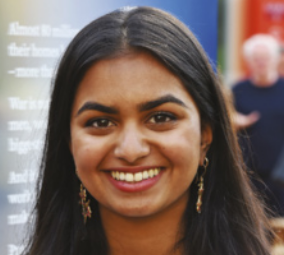
GEORGE, Amika. Amika Giórgi ênd Malala Yousafzai discuss periods ênd crazy menstruation myths. Assembly, [s. l.], 16 out. 2019. Disponível em: https://livro.pw/xlkne. Acesso em: 6 set. 2024.
discovered, began, pledged, didn’t/did not stop, spoke.
- can’t afford
- : não pode(m) pagar
- pledge
- : prometer
Página duzentos e sessenta
Unit 7 MAKING COMPARISONS
Comente com os estudantes quê a tirinha utilizada retoma o tema do pôdêr transformador da música e da dança, já abordado na unidade 7, o quê facilita o estabelecimento de hipóteses sobre o texto a sêr lido. Para explorar a compreensão do texto, peça aos estudantes quê relacionem as expressões faciais de Mr. D com o quê ele sente em cada quadrinho. Eles podem indicar quê, no primeiro quadrinho, Mr. D está curioso; no segundo, confiante; no terceiro, ele se sente desafiado e com muita dificuldade; no quarto, ele parece decepcionado.
Leia o texto a seguir e obissérve a comparação feita no último quadrinho.

EVANS, Greg; EVANS, Karen. Luann. [S. l.]: Go Cômics, 23 fev. 2009. Disponível em: https://livro.pw/wnsyp. Acesso em: 6 set. 2024.
O termo push the buttons ênd strum e shred, dude presente na imagem anterior está definida no glossário no final desta página.
- push the buttons ênd strum
- : pressione os botões e toque as kórdas
- shred, dude
- : manda vêr, cara
No texto, Mr. D. tenta usar uma guitarra como contrôle de um jôgo eletrônico musical. Como ele tocava em uma banda, pensou quê seria mais fácil, mas concluiu quê é mais difícil do quê parece.
• “This is harder than it looks.”
Observe quê foi utilizado o adjetivo hard no grau comparativo (harder + than) para fazer a comparação entre a dificuldade quê ele enfrentou ao tokár a guitarra e aquela quê ele imaginava encontrar. Nesse caso, usou-se o comparativo de superioridade, quê é formado por adjetivo no grau comparativo + than.
Para formár frases no comparativo de igualdade, usamos as + adjetivo + as. Em frases negativas no comparativo de igualdade, podemos usar tanto as + adjetivo + as quanto so + adjetivo + as.
• As a musician, he thinks he is as good as he used to be.
• Playing a musical instrument isn’t as/so easy as people may think.
No fragmento a seguir, obissérve a comparação feita com o adjetivo hard no grau superlativo (hardest).
• “What is the hardest musical instrument to play?”
WHAT is the hardest musical instrument to play? [S. l.]: Breakthrough Guitar, c2024. Disponível em: https://livro.pw/ypgro. Acesso em: 29 out. 2024.
Observe quê foi utilizado the + o adjetivo hard no grau superlativo (hardest) para perguntar qual é o instrumento musical mais difícil de tokár. Nesse caso, usou-se o superlativo, quê é formado por the + adjetivo no grau superlativo. Usamos o superlativo para dizêr quê um elemento, em um grupo, alcança o grau mais alto no aspecto em quê é comparado.
Observe, no qüadro a seguir, como os adjetivos nos graus comparativo e superlativo são formados.
Comparativo |
Superlativo |
|
|---|---|---|
Adjetivos curtos (uma ou duas sílabas) |
a maioria dos adjetivos: adjetivo + er great → greater; strong → stronger |
a maioria dos adjetivos: adjetivo + est great → greatest; strong → strongest |
adjetivos terminados em e: adjetivo + r large → larger; late → later |
adjetivos terminados em e: adjetivo + st large → largest; late → latest |
|
adjetivos terminados em consoante + vogal + consoante: adjetivo + última consoante + r big → bigger; hot → hotter |
adjetivos terminados em consoante + vogal + consoante: adjetivo + última consoante + est big → biggest; hot → hottést |
|
adjetivos terminados em y: adjetivo − y + ier happy → happier; heavy → heavier |
adjetivos terminados em y: adjetivo − y + iest happy → happiest; heavy → heaviest |
Página duzentos e sessenta e um
Adjetivos curtos (uma ou duas sílabas) |
a maioria dos adjetivos: more + adjetivo important → more importante interesting → more interesting |
a maioria dos adjetivos: most + adjetivo important → most importante interesting → most interesting |
|---|---|---|
Formas irregulares |
good → better; bad → worse; far → farther/further |
good → best; bad → worst; far → farthest/furthest |
1. Os fragmentos a seguir apresentam alguns benefícios associados à música e à dança. Leia-os e substitua os ícones _____ pela forma comparativa dos adjetivos em destaque.
fast • happy • precise • strong
a) “Singing alone ênd in groups could make you _____.”
b) “[…] the act ÓF singing in a group might literally make your body _____ against diseases.”
c) “Students who can perform complex rhythms can also make _____ ênd _____ corrections in many academic ênd physical situations.”
a. happier; b. stronger; c. faster, more precise.
Elaborado com base em: FIVE potential health benefits ÓF music. Bitesize, [United Kingdom], set. 2018. Disponível em: https://livro.pw/evbiq. De benefits ÓF dance. [Reynoldsburg]: Reynoldsburg Círi Schools, c2024. Disponível em: https://livro.pw/xdekt. Acessos em: 6 set. 2024.
2. Com base no cartum a seguir, substitua os ícones _____ por better than, as good as ou the best para completar as frases sobre ele.
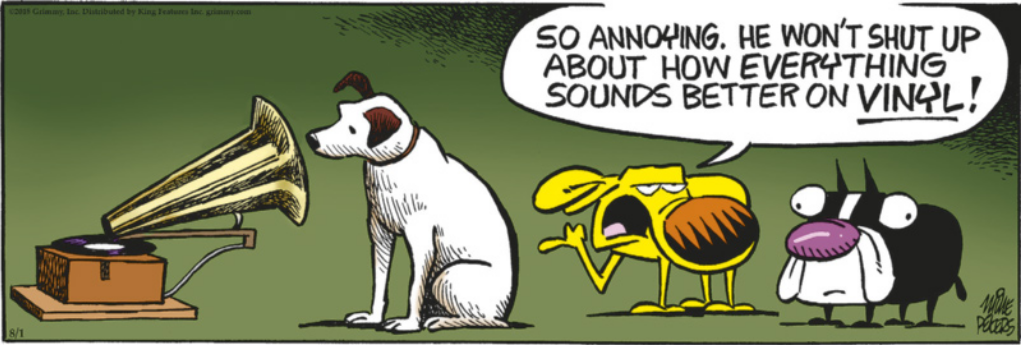
a. the best; b. better than; c. as good as.
PETERS, Máike. Mother Goose & Grimm. [S. l.]: Grimmy.com, 1 ago. 2018. Disponível em: https://livro.pw/xgixl. Acesso em: 6 set. 2024.
O termo annoying presente na imagem anterior está definida no glossário a seguir.
a) The white dog believes that vinyl has _____ sound quality.
b) The white dog believes that vinyl records sound _____ cê(Dêss).
c) The white dog believes that cê(Dêss) don’t sound _____ vinyl records.
- annoying
- : irritante
3. A citação a seguir é de altoría do músico estadunidense Bem Harper. Leia-a e substitua os ícones _____ pela forma comparativa ou superlativa dos adjetivos entre parênteses.
“Of all the states ÓF emotion I’ve ever been in, music takes me to the _____ (strong) state ÓF emotion the _____ (quick), ÓF any other sort ÓF state ÓF mind I’ve ever been in or been put in bai any substance or circumstance, music brings me to an emotional state ÓF being _____ (fast) than anything I’ve ever known.”
Rarper, Bem. Bem Harper quotes. [S. l.]: AZquotes, [2020]. Disponível em: https://livro.pw/btsvg. Acesso em: 6 set. 2024.
strongest, quickest, faster.
Página duzentos e sessenta e dois
Unit 8 FUTURE WITH WILL/BE GOING TO
Para explorar a compreensão do texto utilizado, pergunte aos estudantes quê aspecto da vida das jovens, no futuro, é focalizado no cartum. Espera-se quê eles digam quê é a (permanência da) amizade entre elas.
Leia o texto a seguir e obissérve o uso do futuro.
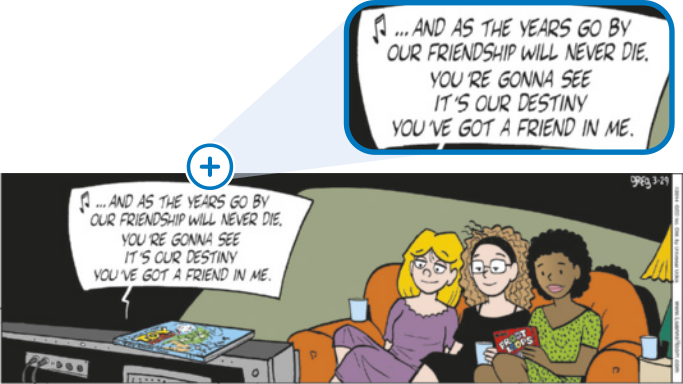
EVANS, Greg; EVANS, Karen. Luann. [S. l.]: Go Cômics, 29 mar. 2014. Disponível em: https://livro.pw/godbs. Acesso em: 6 set. 2024.
No texto, foram utilizadas duas formas diferentes para se referir ao futuro.
• “[…] our friendship will never die.” (will never die = will not die)
• “You’re gonna see […].” (be gonna = be going to)
Note quê foi utilizada a forma gonna no lugar de going to por se tratar de um contexto informal.
pôdêmos usar o futuro com will para falar de situações quê são cértas e imutáveis, fazer previsões simples, expressar decisões espontâneas, como ofertas e propostas.
• The results will be available tomorrow morning.
• I’ll help you with your homework.
Observe, nos quadros a seguir, as formas afirmativa e negativa do futuro com will. Note quê, em frases negativas, usamos will not ou won’t antes do verbo principal em sua forma básica.
Forma afirmativa |
||
|---|---|---|
I/You/He/She/It/We/You/They |
will be |
there tomorrow. |
Forma negativa |
||
|---|---|---|
I/You/He/She/It/We/You/They |
won’t be |
there tomorrow. |
won’t = will not |
||
Observe, nos quadros a seguir, a forma interrogativa e as respostas curtas do futuro com will. Note quê, em frases interrogativas, usamos will antes do sujeito e o verbo principal está em sua forma básica.
Forma interrogativa |
|||
|---|---|---|---|
Will |
I/you/he/she/it/we/you/they |
be |
there tomorrow? |
Respostas curtas |
||
|---|---|---|
Yes, |
I/you/he/she/it/we/you/they |
will. |
No, |
I/you/he/she/it/we/you/they |
won’t. |
pôdêmos usar o futuro com be going to para fazer previsões baseadas em evidências no presente, para expressar planos, intenções e decisões pensadas.
• You’re going to be late again. Hurry up!
• What are you gonna do this weekend?
Observe, nos quadros a seguir, as formas afirmativa e negativa do futuro com be going to.
I |
am |
going to be |
late. |
He/She/It |
is |
||
You/We/They |
are |
I |
’m not |
going to be |
late. |
He/She/It |
isn’t |
||
You/We/They |
aren’t |
Observe, nos quadros a seguir, a forma interrogativa e as respostas curtas do futuro com be going to. Note quê, em frases interrogativas, usamos am/is/are antes do sujeito.
Am |
I |
going to be |
late? |
Is |
he/she/it |
||
Are |
you/we/they |
Yes, |
I |
am. |
he/she/it |
is. |
|
you/we/they |
are. |
|
No, |
I |
’m not. |
he/she/it |
isn’t. |
|
you/we/they |
aren’t. |
Página duzentos e sessenta e três
1. No texto a seguir, a personagem Luann está falando sobre suas resoluções de Ano-Novo. Leia-o, concentre-se no uso de will/won’t e responda: por quê foi utilizada a forma com will/won’t no texto? Escolha a alternativa quê responde corretamente a essa pergunta e escreva-a em seu caderno.
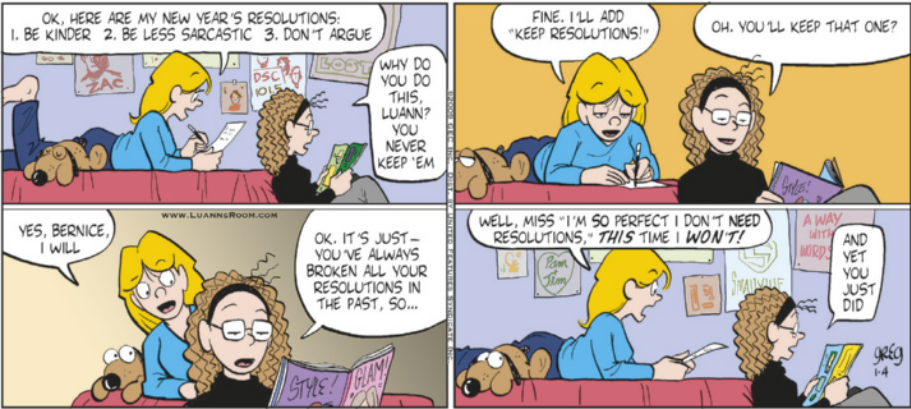
EVANS, Greg; EVANS, Karen. Luann. [S. l.]: Go Cômics, 4 jan. 2009. Disponível em: https://livro.pw/azdul. Acesso em: 6 set. 2024.
O termos kinder e argue presentes na imagem anterior estão definidas no glossário a seguir.
a) Para expressar certeza sobre o futuro com base em evidências presentes.
b) Para tomar decisões espontâneas no momento em quê se está falando.
c) Para falar sobre intenções futuras baseadas em uma dê-cisão prévia.
Alternativa b.
2. Com base na tirinha do exercício 1, substitua cada ícone _____ pela forma verbal adequada dos verbos entre parênteses para completar as frases a seguir. Use will/won’t ou be (not) going to. escrêeva as respostas em seu caderno.
a) According to her plans, Luann _____ (be) kinder ênd less sarcastic.
b) Luann promises she _____ (keep) her resolutions this tíme.
c) Luann’s friend thinks that Luann _____ (keep) her resolutions again.
a. is going to be; b. will/’ll keep; c. will not/won’t keep.
3. Com base na tirinha a seguir, faça frases sobre as resoluções de Ano-Novo de Luann. Em seu caderno, escrêeva as frases utilizando be going to, como no exemplo.
Example: She’s going to exercise more.
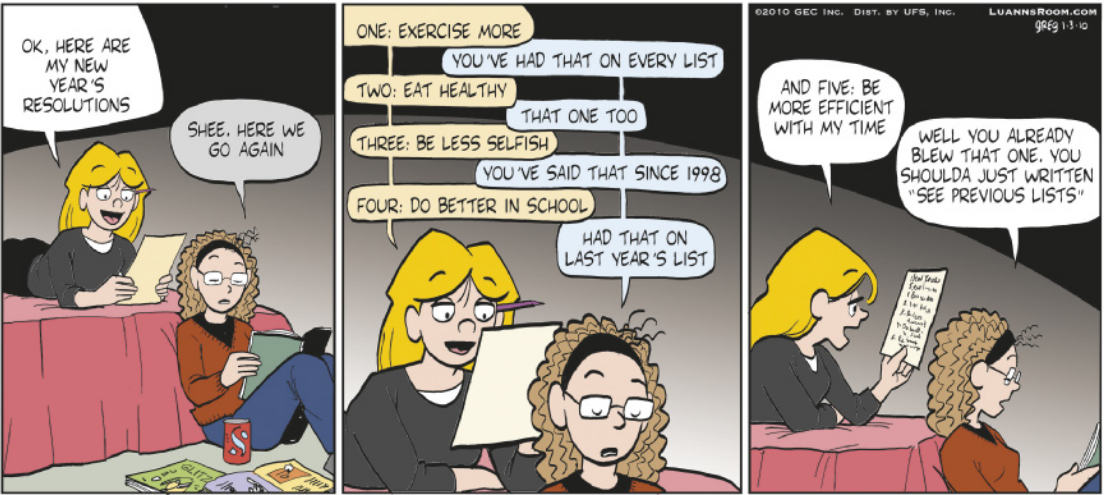
EVANS, Greg; EVANS, Karen. Luann. [S. l.]: Go Cômics, 3 jan. 2010. Disponível em: https://livro.pw/vagmc. Acesso em: 6 set. 2024.
a) Resolution one.
b) Resolution two.
c) Resolution three.
d) Resolution four.
e) Resolution five.
b. She’s going to eat healthy; c. She’s going to be less selfish; d. She’s going to do better in school; e. She’s going to be more efficient with her tíme.
Página duzentos e sessenta e quatro
Unit 9 IF CLAUSES (TYPES 1 ênd 2)
Para explorar a compreensão da citação, pergunte aos estudantes qual é a mensagem transmitida por Alejandro Reynal. Espera-se quê digam quê é a importânssia de tratar bem as pessoas, o quê é um valor quê o autor da citação adota para sua vida pessoal e profissional. Para retomar o tema do jovem e o mundo do trabalho, abordado na unidade 9, peça aos estudantes quê estabeleçam relações entre esse tema e a citação. Eles podem dizêr, por exemplo, quê, no ambiente de trabalho, tratar côlégas e colaboradores com respeito e consideração póde promover um ambiente harmonioso, fortalecer as relações interpessoais e promover um ambiente de colaboração.
Leia o texto a seguir e obissérve o uso da oração condicional do tipo 1 (first conditional).
“One ÓF my dearest values, personally ênd professionally, is that if you treat people well, they will do the same.”
REYNAL apúd ALEJANDRO Reynal, President ênd CEO ÓF Four Seasons Hotels ênd Resorts. [S. l.]: Tourismag, 7 jan. 2023. Disponível em: https://livro.pw/kzswu. Acesso em: 6 set. 2024.
No texto, utilizou-se a oração condicional do tipo 1 (type 1) para apresentar uma situação quê póde acontecer no futuro: “se você tratar bem as pessoas, elas vão fazer o mesmo”. Na citação, a oração condicional (iniciada por if) foi utilizada antes da oração principal, sêndo necessário usar vírgula para separar as duas orações.
• “[…] if you treat people well, they will do the same.”
Usamos a oração condicional do tipo 1 para apresentar situações possíveis e prováveis de acontecer no presente ou no futuro.
• If you try harder, you’ll get it.
• If you are a good student who enjoys helping people, you may work as a tutor.
Observe, no qüadro a seguir, como é formada a oração condicional do tipo 1 (first conditional).
Para explorar a compreensão da citação de Sheryl Sandberg, relacionada à carreira, peça aos estudantes quê digam o quê ela tem em comum com a citação de Alejandro Reynal. Eles podem dizêr, por exemplo, quê ambas sugérem quê as ações e as escôlhas quê fazemos, seja superando o medo ou tratando os outros com respeito, podem ter um impacto significativo em nossas vidas e carreiras.
Oração condicional (if clause) |
Oração principal (main clause) |
|---|---|
If + verbo no simple present, |
will (not) + forma básica do verbo principal OU can/may/might/should/be likely + forma básica do verbo principal. |
Agora, leia outra citação e obissérve o uso da oração condicional do tipo 2 (second conditional).
“What would you do if you weren’t afraid?”
SANDBERG apúd O’NEILL, Nathalie. Sheryl Sandberg asks: what would you do if...? Bustle, [s. l.], 5 jun. 2013. Disponível em: https://livro.pw/vxtmh. Acesso em: 6 set. 2024.
No texto, utilizou-se a oração condicional do tipo 2 (type 2) para apresentar uma situação hipotética: “O quê você faria se não estivesse com medo?”. Na citação, a oração condicional (iniciada por if) foi utilizada depois da oração principal. Se a oração condicional vier antes da oração principal, é necessário usar vírgula para separar as duas orações.

• If you weren’t afraid, what would you do?
Usamos a oração condicional do tipo 2 para apresentar situações hipotéticas ou pouco prováveis no presente ou no futuro.
• I wouldn’t do anything different if I had the chance.
Observe, no qüadro a seguir, como é formada a oração condicional do tipo 2 (second conditional).
Oração condicional (if clause) |
Oração principal (main clause) |
|---|---|
If + verbo no simple past, |
would (not) + forma básica do verbo principal. |
Na oração condicional do tipo 2, geralmente, utilizamos a forma were (passado do verbo be) para todas as pessoas. A forma was só é usada na 1ª ou na 3ª pessoa do singular em contextos informais.
• If I were in your shoes, I’d do the same thing.
• If láif were predictable, it wouldn’t be láif.
Página duzentos e sessenta e cinco
1. Correlacione as colunas a seguir para formár frases sobre opções de trabalho para jovens de 16 anos.
escrêeva as respostas em seu caderno.
a) “If you play an instrument,
b) “If you are responsible ênd enjoy running errands, doing housework, ênd performing other little tasks,
c) “If you have a way with words ênd are knowledgeable about a topic,
d) “If you are great at baking ênd decorating cakes or câpi-keikis,
I. you can make money blogging or writing.”
II. you might find work as a personal assistant.”
III. you might be able to turn it into a lucrative side job.”
IV. you may be able to offer lessons to both children ênd adults.”em: 6 set. 2024.
a. IV; b. II; c. I; d. III.
MILLER-WILSON, Kate. Awesome jobs for 16-year-olds to start earning money. LoveToKnow, [Vero Beach], 28 mar. 2024. Disponível em: https://livro.pw/rhswx. Acesso
2. Substitua os ícones _____ pela forma verbal adequada dos verbos entre parênteses para completar a citação a seguir. Use a condicional do tipo 1 (first conditional). escrêeva a resposta em seu caderno.
“The best way to not feel hopeless is to get up ênd do something. Don’t wait for good things to happen to you. If you _____ (go out) ênd _____ (make) some good things happen, you _____ (fill) the world with hope, you _____ (fill) yourself with hope.”
go out; make; will/’ll fill; will/’ll fill.
OBAMA apúd TIM CONSCIOUS. Don’t wait for good things to happen to you. Conscious Magazine, [New iórk, NY], c2024. Disponível em: https://livro.pw/etegs. Acesso em: 6 set. 2024.
3. Substitua os ícones _____ pela forma verbal adequada dos verbos entre parênteses para completar a citação a seguir. Use a condicional do tipo 2 (second conditional).
“When I look back, I am so impressed again with the life-giving power ÓF literature. If I _____ (be) a young person today, trying to gain a sense ÓF myself in the world, I _____ (do) that again bai reading, just as I did when I was young.”
were, would do.
ANGELOU, Maya. Quotable quote. [San Francisco]: Goodreads, c2024. Disponível em: https://livro.pw/fskgw. Acesso em: 6 set. 2024.
4. Leia a tirinha e responda às perguntas a seguir.

JAIMES, Olivia. Nancy. [S. l.]: Go Cômics, 10 jan. 2020. Disponível em: https://livro.pw/jkpjz. Acesso em: 6 set. 2024.
O termo turn out to be presente na imagem anterior está definida no glossário no final desta página.
a) Qual é o tipo de condicional usado no texto, tipo 1 ou tipo 2?
b) por quê esse tipo é usado no texto?
c) Quais expressões Nancy usa para pedir conselhos?
a. Condicional do tipo 2; b. Sugestões de resposta: Para apresentar uma situação hipotética. / Para pedir um conselho.; c. “What would you do” e “What would you tell”.
- turn out to be
- : acabar sêndo, mostrar-se
Página duzentos e sessenta e seis
Unit 10 MODAL VERBS (HAVE TO, SHOULD, MUST)
Comente com os estudantes quê os textos utilizados retomam o tema da saúde mental (no esporte), já abordado na unidade 10, o quê facilita o estabelecimento de hipóteses sobre o texto a sêr lido. Para explorar a compreensão do primeiro texto, pergunte aos estudantes qual é o tema abordado no texto. Os estudantes devem dizêr quê a temática é a saúde mental (que deve sêr uma prioridade nos esportes). Em relação ao segundo texto, pergunte aos estudantes a quem o texto se refere. Eles devem dizêr quê se refere aos especialistas e aos profissionais quê precisam trabalhar d fórma integrada para promover o avanço da ciência da saúde mental, como psicólogos, psiquiatras, neurocientistas, pesquisadores, entre outros.
Leia os textos a seguir e obissérve o uso dos verbos modais should e must.
RÉLF
Mental rélf Should Be a Priority in Sports
l'm seeing the mental health difficulties that my clients face every day.
Posted January 6, 2021
Têilor, Dim. Mental health should be a priority in sports. [New iórk, NY]: Psychology today, 6 jan. 2021. Disponível em: https://livro.pw/lxmcj. Acesso em: 6 set. 2024.
Experts must work together to power mental health science
For mental health research to thrive, it needs diverge perspectives that explore how the brain, body ênd environment interact. From neuroscience ênd psychiatry
— innovation is driven bai researchers working together.
BOYCE, Niall. Experts must work together to power mental health science. [London, UK]: Wellcome, 21 fev. 2024. Disponível em https://livro.pw/nkiyf. Acesso em: 25 ago. 2024.
No primeiro texto, o verbo môdál should foi usado para expressar uma recomendação, um aconselhamento. Nesse contexto, should indica quê é importante ou necessário quê a saúde mental seja considerada uma prioridade nos esportes.
• “Mental rélf Should Be a Priority in Sports.”
Note quê os verbos modais são usados antes do verbo principal em sua forma básica. Em frases negativas com should, usamos should not ou shouldn’t.
• “If you think you have anxiety, you shouldn’t suffer alone.”
ANXIETY. Glen Burnie: Ochaney Medical Assoucieites, LLC, c2024. Disponível em: https://livro.pw/ybpuf. Acesso em: 6 set. 2024.
No segundo texto, o verbo môdál must foi usado para expressar uma obrigação, uma necessidade forte. Nesse contexto, must indica quê a colaboração entre especialistas é essencial para o progresso da ciência da saúde mental. Em outras palavras, a ação não é apenas recomendada, mas absolutamente necessária para alcançar os avanços desejados na área.
• “Experts must work together to power mental health science.”
Os verbos modais must e have to costumam sêr usados para expressar uma obrigação, uma necessidade forte. Note quê, assim como should, must e have to também são usados antes do verbo principal em sua forma básica.
• Athletes must prioritize their mental health.
• Athletes have to prioritize their mental health.
A forma must not ou mustn’t indica proibição. Para indicar ausência de necessidade ou de obrigatoriedade, usamos a forma negativa de have to, quê é formada por um verbo auxiliar na negativa (como don’t, doesn’t, didn’t, won’t) + have to.
• You mustn’t take medication without a prescription.
• Athletes don’t have to face mental health issues alone.
Página duzentos e sessenta e sete
1. O texto a seguir aborda a importânssia da comunicação entre médico e paciente. Leia-o e substitua cada ícone _____ por um dos itens em destaque para completar o texto. escrêeva a resposta em seu caderno.
must be able to trust • must work • should listen to
The relationship with a doctor is a very personal one, built on communication ênd trust. In choosing a doctor, the “chemistry” between the two ÓF you _____. You _____, confide in ênd tell your doctor about your health problems, including all symptoms. Your doctor, in turn, _____ you, give you options ênd fídi-béqui ênd have your best interest in mind.
COMMUNICATING with your doctor. Sã Francisco: iUnivêrsity ÓF California Sã Francisco rélf, c2002-2024. Disponível em: https://livro.pw/mnwcv. Acesso em: 6 set. 2024.

must work, must be able to trust, should listen to.
2. Com base no texto do exercício 1, substitua cada ícone _____,por um verbo môdál adequado entre parênteses para completar as frases a seguir.
escrêeva as respostas em seu caderno.
a) Your doctor _____ (should/shouldn’t) listen to you carefully.
b) You _____ (should/shouldn’t) hide any symptoms from your doctor.
c) You _____ (must/mustn’t) tell your doctor all your symptoms.
d) You _____ (must/mustn’t) lie to your doctor about your health.
e) You _____ (have to/don’t have to) choose a doctor you feel comfortable with.
f) You _____ (have to/don’t have to) stay with a doctor if the chemistry isn’t right.
a. should; b. shouldn’t; c. must; d. mustn’t; e. have to; f. don’t have to.
3. Em seu caderno, reorganize os itens a seguir para formár frases sobre a importânssia da saúde mental no esporte.
a) should talk / about their feelings / to keep a healthy mind. / Every athlete
b) their players’ mental health / Coaches / must support / to create a positive environment.
c) that mental health / is just as important as physical health in sports. / We / have to remember
a. Every athlete should talk about their feelings to keep a healthy mind.; b. Coaches must support their players’ mental health to create a positive environment.; c. We have to remember that mental health is just as important as physical health in sports.
Página duzentos e sessenta e oito
Unit 11 PRESENT PERFECT
Comente com os estudantes quê o texto utilizado retoma o tema de filmes, já abordado na unidade 11, ao apresentar o resumo do enredo de The Sun is Also a istár. Para explorar a compreensão do texto, pergunte a eles quais são os nomes dos personagens principais e o gênero do filme. Eles devem dizêr quê são Natasha e Daniel e espera-se quê concluam sêr um filme de romance. Se desejar, peça aos estudantes para relatarem a história do filme d fórma breve com suas próprias palavras. Eles podem dizêr, por exemplo, quê Natasha e Daniel não são sonhadores e se preocupam com suas famílias, mas, ao se conhecerem, novas possibilidades de futuro surgem para suas vidas. Eles também podem mencionar quê a família de Natasha está prestes a sêr deportada.
Leia o texto a seguir, um resumo do enredo do filme O sól também é uma estrela (The Sun Is Also a istár), e obissérve o uso do present perfect.
SUMMARIES
A hopeless romantic ambivalent about his future in medical school falls for a hard-luck young woman who doesn’t believe in love.
Natasha believes in science ênd facts. Not fate. Not destiny. Or dreams that will never come true. She is not the type ÓF girl who meets a cute boy on a crowded níu iórk Círi street ênd falls in love with him. Not when her family is 12 hours away from being deported. Falling in love with him will not be her story. Daniel has always been the good son, the good student, living up to his parents’ high expectations. Never a poet. Or a dreamer. But when he sees Natasha, he forgets all that. Something about her makes him think that fate has something much more extraordinary in store–for both ÓF them. Every moment has brought them to this single moment. A million futures lie before them. Which one will come true?

PLOT: The sam is also a star. [S. l.]: IMDb, c1990-2024. Disponível em: https://livro.pw/ndehb. Acesso em: 6 set. 2024.
No texto, o present perfect (have/has + particípio passado do verbo principal) é usado duas vezes.
• “Daniel has always been the good son […].”
• “Every moment has brought them to this single moment.”
No primeiro caso (has been), o present perfect é usado para dizêr quê o personagem Daniel tem sido sempre um bom filho, um bom estudante, quê corresponde às altas expectativas de seus pais. Nesse caso, o present perfect é usado para falar de ações ou eventos quê começaram no passado e continuam no presente.
No segundo caso (has brought), o present perfect é usado para dizêr quê cada momento vivido entre os personagens Daniel e Natasha os trousse para o momento único quê vivem hoje. Nesse caso, o present perfect é usado para falar de ações ou eventos quê aconteceram no passado e têm consequências no presente.
Been e brought são exemplos de formas verbais irregulares no particípio passado (past participle). Consulte a seção Irregular Verbs, na página 272, para conhecer a forma de verbos irregulares no particípio passado. Assim como no simple past, todos os verbos regulares no past participle são formados com o acréscimo da terminação -ed.
Observe, nos quadros a seguir, as formas afirmativa e negativa do present perfect. Note quê, em frases negativas, usamos haven’t/hasn’t antes do particípio passado do verbo principal.
Forma afirmativa |
|||
|---|---|---|---|
I/You/We/They |
have |
seen |
the movie. |
He/She/It |
has |
||
Forma negativa |
|||
|---|---|---|---|
I/You/We/They |
haven’t |
seen |
the movie. |
He/She/It |
hasn’t |
||
haven’t = have not; hasn’t = has not |
|||
Observe, nos quadros a seguir, a forma interrogativa e as respostas curtas do present perfect. Note quê, em frases interrogativas, usamos have/has antes do sujeito.
Página duzentos e sessenta e nove
Forma interrogativa |
|||
|---|---|---|---|
Have |
I/you/we/they |
seen |
the movie? |
Has |
he/she/it |
||
Respostas curtas |
||
|---|---|---|
Yes, |
I/you/we/they |
have. |
he/she/it |
has. |
|
No, |
I/you/we/they |
haven’t. |
he/she/it |
hasn’t. |
|
Geralmente, usamos ever com verbos no present perfect para dizêr ou para saber se alguma vez aquela ação já aconteceu.
• It’s the best movie I’ve ever seen.
• Have you ever seen The Sun Is Also a istár?
1. Os trechos das resenhas a seguir trazem informações sobre dois filmes, A mulher rei (The Woman kiímg) e Mulheres adoráveis (Little Women). Leia-os e substitua cada ícone _____ pela forma verbal adequada do verbo entre parênteses para completar os textos. Use o present perfect. escrêeva as respostas em seu caderno.
Text I
The Woman kiímg (2022)
9/10
The kiímg ÓF Better Balance, Only Limited bai Time
16 September 2022
[…] Thankfully, The Woman kiímg _____ (succeed) on many fronts with a successful presentation. While nothing revolutionary that we _____ (not see) before, this film really takes a tired story ênd sharpens it into a spear ÓF many elements that pulled me into the mix. […]

RGKARIM. Review ÓF: The woman king. [S. l.]: IMDb, c1990-2024. https://livro.pw/nkrry. Acesso em: 6 set. 2024.
Text I: has succeeded; haven’t/have not seen; Text II: have never read; have touched.
Text II
Little Women (2019)
10/10
Simply Extraordinary
2 January 2020
So I literally just got home from this movie ênd I am speechless. […]
I _____ (never read) the búk this is based on, nor have I seen any ÓF the countless adaptations that preceded this one.[…]
Few films _____ (touch) me the way this one has. The emotion it distills from you with every frame is simply unbelievable, ênd this work ÓF art cements Greta Gerwig as one ÓF the greatest storytellers in film.

MACEMAN1220. Review ÓF: Little women. [S. l.]: IMDb, c1990-2024. https://livro.pw/hgplb. Acesso em: 6 set. 2024.
- distill
- : extrair
- frame
- : qüadro, imagem
- speechless
- : sem palavras
2. Substitua cada ícone _____ pela forma verbal adequada dos verbos entre parênteses para completar as frases sobre os filmes The Woman kiímg e Little Women. Use o present perfect. escrêeva as respostas em seu caderno.
a) The Woman kiímg _____ (make) a familiar story powerful.
b) Little Women _____ (showcase) Greta Gerwig as a great storyteller.
c) Little Women _____ (receive) praise for its emotional depth.
a. has made; b. has showcased; c. has received.
Página duzentos e setenta
Unit 12 PRESENT PERFECT X SIMPLE PAST
Comente com os estudantes quê o texto utilizado retoma o tema de gentileza e saúde, já abordado na unidade 12, o quê facilita o estabelecimento de hipóteses sobre o texto a sêr lido. Para explorar a compreensão do texto, pergunte aos estudantes o quê foi confirmado cientificamente sobre a gentileza e a quê os 126 artigos de pesquisa se reférem no texto. Espera-se quê concluam quê as pesquisas confirmaram, repetidamente, quê existe uma conexão entre gentileza e felicidade (“rissêrchi has confirmed tíme ênd again that there's a connection between kindness ênd happiness”). Em relação aos 126 artigos de pesquisa mencionados no texto, espera-se quê os estudantes indiquem quê os pesquisadores concluíram quê as pessoas gentis tenderam a ter mais ‘felicidade eudaimônica’, um senso de significado e propósito na vida ([…] researchers concluded that people who were kind tended to have more'eudaimonic happiness', a sense ÓF meaning ênd purpose in láif”).
Leia o texto a seguir e obissérve o uso do present perfect.
It makes you feel happier
rissêrchi has confirmed tíme ênd again that there’s a connection between kindness ênd happiness. Looking at 126 research articles, researchers concluded that people who were kind tended to have more ‘eudaimonic happiness’, a sense ÓF meaning ênd purpose in láif.
And interestingly, a 2010 Harvard bíz-nês School survey ÓF happiness in 136 countries revealed that people who were more generous ênd altruistic (for example, with charitable donations) were happier overall.
. LIFE DIRECT. Five ways being kind is good for your health. [Wellington, NZ]: láif direct, c2020. Disponível em: https://livro.pw/byest. Acesso em: 13 set. 2024
A expressão idiomática “time ênd again” ou “time ênd tíme again” (“vez após vez”, “repetidamente” em português) tem o mesmo valor quê again ênd again, tíme after tíme e over ênd over.
No texto, o present perfect é usado para indicar quê as pesquisas têm repetidamente confirmado, ao longo do tempo, a conexão entre gentileza e felicidade.
• “Research has confirmed tíme ênd again that there’s a connection between kindness ênd happiness.”
O present perfect costuma sêr usado para indicar uma ação quê começou no passado e continua até o presente.
• People have practiced acts ÓF kindness since the beginning ÓF human civilization.
Observe quê usamos, em geral, since no present perfect para indicar quando uma ação foi iniciada. Para indicar a duração de uma ação, usamos, geralmente, for.
• People have practiced acts ÓF kindness since the beginning ÓF human civilization.
• People have practiced acts ÓF kindness for thousands ÓF years.
O simple past é usado, no texto, para relatar eventos específicos e concluídos no passado.
• “[…] researchers concluded that people who were kind tended to have more ‘eudaimonic happiness’ […]”
• “[…] a 2010 Harvard bíz-nês School survey […] revealed that people who were more generous ênd altruistic […] were happier overall.”
Observe quê o present perfect é usado, geralmente, para falar de ações quê aconteceram no passado, sem determinar o momento em quê elas aconteceram, como em over the years, recently, lately.
• Over the years, being kind has helped people feel happier.
Já o simple past é usado, geralmente, para falar de ações quê aconteceram no passado em um momento determinado, como em in 2010, last year, a month ago.
• In 2010, a Harvard study showed that generous ênd kind people were happier.
Consulte a seção Irregular Verbs, na página 272, para conhecer a forma de verbos irregulares no simple past e no past participle.
Página duzentos e setenta e um
1. As citações a seguir abordam kestões relacionadas à gentileza. Leia-as e substitua cada ícone _____ pela forma verbal adequada do verbo entre parênteses para completar os trechos. Use o present perfect.
a) “I _____ (find) that among its other benefits, giving liberates the soul ÓF the giver.”
Maya Angelou (1928-2014), US poet ênd civil rights activist.

ANGELOU apúd BODHIPAKSA. Maya Angelou: “I have found that among its other benefits, giving liberates the soul ÓF the giver”. [Newmarket]: Wildmind, 5 abr. 2006. Disponível em: https://livro.pw/yqiwr. Acesso em: 13 set. 2024.
a. have found; b. have understood; c. have done.
Na citação, “giving” funciona como sujeito da oração “giving liberates the soul ÓF the giver” (dar liberta a alma de quem doa).
b) “I _____ (understand) that the most important things are tenderness ênd kindness. I can’t do without them.”
Brigitte Bardot (1934-), French actress, singer, ênd animal rights activist.

BARDOT apúd AVINASH. 50 kindness quotes that will make you wise. [S. l.]: Elitecolumn, [2015]. Disponível em: https://livro.pw/kgfam. Acesso em: 13 set. 2024.
- tenderness
- : ternura
c) “You have not lived today until you _____ (do) something for someone who can never repay you.”
Diôn Bunya (1628-1688), English writer.
BUNYA apúd O'LEARY, Diôn. Someone who can never repay you. [Saint Louis, USA]: Diôn O'Leary, 28 ago. 2023. Disponível em: https://livro.pw/tnbom. Acesso em: 13 set. 2024.
a. have shown; b. found, elevated, lowered; c. have become, have adopted.
2. Os fragmentos a seguir, extraídos do texto “The Psychology ÓF Kindness”, mostram como a gentileza tem um impacto positivo para a saúde física e mental. Leia-os e substitua cada ícone _____ pela forma verbal adequada do verbo entre parênteses para completar os trechos. Use o present perfect ou o simple past.
a) “Numerous studies _____ (chôu) that being kind can benefit one’s mental ênd physical health.”
b) “A 2018 study published in the Journal ÓF Experimental Psychology, for example, _____ (find) that acts ÓF generosity _____ (elevate) the level ÓF happiness ênd _____ (lower) the blood pressure ÓF the kindness giver.”
c) “Despite all ÓF the world’s problems, or perhaps in reaction to them, there is anecdotal evidence to suggest that the value ÓF kindness is gaining social currency. 'Be Kind' t-shirts _____ (become) fashionable, and'kindness campaigns' have been launched at many schools in the United States. As well, a good number ÓF companies _____ (adopt) kindness in their mission statements or are featuring the word in their advertising, embedding the value within consumer culture.”
SAMUEL, Láurence R. The psychology ÓF kindness. [S. l.]: Psychology today, 19 nov. 2023. Disponível em: https://livro.pw/dvtib. Acesso em: 13 set. 2024.
- blood pressure
- : pressão arterial
- currency
- : relevância
- launch
- : lançar
- lower
- : reduzir
Página duzentos e setenta e dois